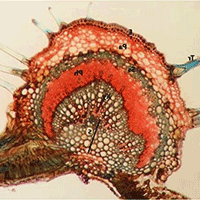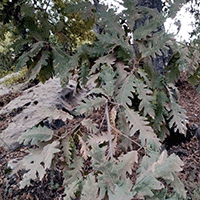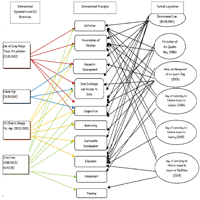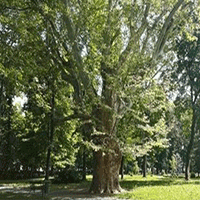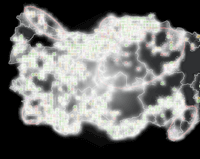Dust is one of the main environmental challenges in most arid zone cities of Iran. Tree plantation and forest belts can provide a cost-effective and eco-friendly solution to mitigate dust pollution. Air pollution tolerance index (APTI) based on a combination of total chlorophyll (TChl), relative water content (RWC), ascorbic acid (AsA), and leaf pH is considered as one of the most important means for determining sensitive and tolerant plant species for greening. The present study aimed to evaluate the dust capturing efficiency and APTI of Fraxinus rotundifolia Mill., Morus alba L., Celtis caucasica Willd., and Melia azedarach L., four tree species commonly used in urban green areas of most cities in Iran. As a completely randomized design, 256 saplings were grown in four plastic sheets (64 saplings of four species in each chamber) and the dust was applied at concentrations of 0, 300, 750, and 1500 μg m-3 once a week for 70 days. The results revealed that dust accumulation was greatest in the 750 and 1500 μg m-3 treatment in the following order: M. alba > C. caucasica > F. rotundifolia > M. azedarach. In all species, pH, RWC, AsA, and TChl diminished with increasing dust concentration. A decline in APTI of 0 to 1500 μg m-3 was observed in all species. At 750 μg m-3, only M. alba was tolerant to dust and the other species were intermediate. At 1500 μg m-3, M. alba and M. azedarach showed to be intermediate while two other species were sensitive. The greatest relationship was found between APTI and RWC (R2= 0.85), followed by APTI and AsA (R2 = 0.82). Although C. caucasica showed a high capacity for dust accumulation at 1500 μg m-3, it was found to be sensitive and can, therefore, be used as a dust pollution bioindicator. F. rotundifolia and C. caucasica are not suitable for plantation in urban green spaces where dust concentration is 1500 μg m-3. M. alba appeared to be a tolerant species adaptable to arid urban environments with a potential for reducing dust levels by sinking its particles.
Keywords
, , , ,
Citation
Javanmard Z, Kouchaksaraei Tabari M, Bahrami H, Hosseini SM, Sanavi SAMM, Struve D (2019). Dust collection potential and air pollution tolerance indices in some young plant species in arid regions of Iran. iForest 12: 558-564. - doi: 10.3832/ifor3063-012
Academic Editor
Silvano Fares
Paper history
Received: Feb 09, 2019
Accepted: Oct 12, 2019
First online: Dec 17, 2019
Publication Date: Dec 31, 2019
Publication Time: 2.20 months
© SISEF - The Italian Society of Silviculture and Forest Ecology 2019
Open Access
This article is distributed under the terms of the Creative Commons Attribution-Non Commercial 4.0 International (https://creativecommons.org/licenses/by-nc/4.0/), which permits unrestricted use, distribution, and reproduction in any medium, provided you give appropriate credit to the original author(s) and the source, provide a link to the Creative Commons license, and indicate if changes were made.

Breakdown by View Type
(Waiting for server response...)
Article Usage
Total Article Views: 45547
(from publication date up to now)
Breakdown by View Type
HTML Page Views: 38598
Abstract Page Views: 3532
PDF Downloads: 2549
Citation/Reference Downloads: 6
XML Downloads: 862
Web Metrics
Days since publication: 2191
Overall contacts: 45547
Avg. contacts per week: 145.52
Article Citations
Article citations are based on data periodically collected from the Clarivate Web of Science web site
(last update: Mar 2025)
Total number of cites (since 2019): 8
Average cites per year: 1.14
Publication Metrics
by Dimensions ©
Articles citing this article
List of the papers citing this article based on CrossRef Cited-by.
(1)
Achakzai K, Khalid S, Adrees M, Bibi A, Ali S, Nawaz R, Rizwan M (2017)Air pollution tolerance index of plants around brick kilns in Rawalpindi. Pakistan. Journal of Environmental Management 190: 252-258.
CrossRef |
Gscholar
(2)
Alavi M, Sharifi M (2015)Experimental effects of sand-dust storm on tolerance index, percentage phototoxicity and chlorophyll a fluorescence of
Vigna radiata L. Proceedings of the International Academy of Ecology and Environmental Sciences 5: 16-24.
Gscholar
(3)
Amiraslani F, Dragovich D (2011)Combating desertification in Iran over the last 50 years: an overview of changing approaches. Journal of Environmental Management 92: 1-13.
CrossRef |
Gscholar
(4)
Arnon DI (1949)Copper enzymes in isolated chloroplasts: polyphenoloxidase in beta vulgaris. Plant Physiology 24: 1-15.
CrossRef |
Gscholar
(5)
Arslan M, BoyBay M (1990)A study on the characterization of dust fall. Atmospheric Environment 24: 2667-2671.
CrossRef |
Gscholar
(6)
Bharti SK, Trivedi A, Kumar N (2018)Air pollution tolerance index of plants growing near an industrial site. Urban Climate 24: 820-829.
CrossRef |
Gscholar
(7)
Das S, Prasad P (2010)Seasonal variation in air pollution tolerance indices and selection of plant species for industrial areas of Rourkela. Indian Journal of Environmental Protection 30: 978-988.
Online |
Gscholar
(8)
Gholami A, Mojiri A, Amini H (2016)Investigation of the air pollution tolerance index (APTI) using some plant species in Ahvaz region. Journal of Animal and Plant Sciences 26: 475-480.
Online |
Gscholar
(9)
González JA, Prado FE, Piacentini RD (2014)Atmospheric dust accumulation on native and non-native species: effects on gas exchange parameters. Journal of Environmental Quality 43: 801-808.
CrossRef |
Gscholar
(10)
Goudie AS (2014)Desert dust and human health disorders. Environment International 63: 101-113.
CrossRef |
Gscholar
(11)
Hatami Z, Rezvani Moghaddam P, Rashki A, Nasiri Mahallati M, Habibi Khaniani B (2018)Effects of desert dust on yield and yield components of cowpea (
Vigna unguiculata L.). Archives of Agronomy and Soil Science 64: 1446-1458.
CrossRef |
Gscholar
(12)
Heidarian P, Joudaki M, Darvishi Khatoni J, Shahbazi R (2017)Recognized dust sources in Khuzestan province. Geosciences 27: 33-46. [in Persian with English abstract]
Gscholar
(13)
Heydarnezhad S, Ranjbar-Fordoie A (2014)Impact of aeolian dust accumulation on some biochemical parameters in black saxaul (
Haloxylon aphyllum Bunge.) leaves: a case study for the Aran-Bidgol region, Iran. International Journal of Forest, Soil and Erosion 4: 11-15.
CrossRef |
Gscholar
(14)
Hirano T, Kiyota M, Aiga I (1995)Physical effects of dust on leaf physiology of cucumber and kidney bean plants. Environmental Pollution 89: 255-261.
CrossRef |
Gscholar
(15)
Hayat S, Khalique G, Irfan M, Wani AS, Tripathi BN, Ahmad A (2012)Physiological changes induced by chromium stress in plants: an overview. Protoplasma 249: 599-611.
CrossRef |
Gscholar
(16)
Javanmard Z, Tabari Kouchaksaraei M, Bahrami HA, Hosseini SM, Modares Sanavi, SAM (2019)Effects of dust on morpho-physiological response of
Fraxinus rotundifolia Mill. seedling, Iranian Journal of Forest. [in press] [in Persian with abstract in English]
Gscholar
(17)
Karami L, Ghaderi N, Javadi T (2017)Morphological and physiological responses of grapevine (
Vitis vinifera L.) to drought stress and dust pollution. Folia Horticulturae 29: 231-240.
CrossRef |
Gscholar
(18)
Kaur M, Nagpal A (2017)Evaluation of air pollution tolerance index and anticipated performance index of plants and their application in development of green space along the urban areas. Environmental Science and Pollution Research 24: 18881-18895.
CrossRef |
Gscholar
(19)
Keller T, Schwager H (1977)Air pollution and ascorbic acid. European Journal of Plant Physiology 7: 338-350.
CrossRef |
Gscholar
(20)
Lepeduš H, Cesar V, Suver M (2003)The annual changes of chloroplast pigments content in current-and previous-year needles of Norway spruce (
Picea abies L. Karast.) exposed to cement dust pollution. Acta Botanica Croatica 62: 27-35.
Online |
Gscholar
(21)
Maity S, Mondal I, Das B, Mondal AK, Bandyopadhyay J (2017)Pollution tolerance performance index for plant species using geospatial technology: evidence from Kolaghat Thermal Plant area, West Bengal, India. Spatial Information Research 25: 57-66.
CrossRef |
Gscholar
(22)
Maletsika PA, Nanos GD, Stavroulakis GG (2015)Peach leaf responses to soil and cement dust pollution. Environmental Science and Pollution Research 22: 15952-15960.
CrossRef |
Gscholar
(23)
Mohammadi A, Mokhtari M, Mosleh Arani A, Taghipour H, Hajizadeh Y, Fallahzadeh H (2018)Biomonitoring levels of airborne metals around Urmia Lake using deciduous trees and evaluation of their tolerance for greenbelt development. Environmental Science and Pollution Research 25: 21138-21148.
CrossRef |
Gscholar
(24)
Ninave SY, Chaudhari PR, Gajghate DG, Tarar JT (2001)Foliar biochemical features of plants as indicators of air pollution. Bulletin of Environmental Contamination and Toxicology 67: 133-140.
CrossRef |
Gscholar
(25)
Noor MJ, Sultana S, Fatima S, Ahmad M, Zafar M, Sarfraz M, Balkhyour MA, Saif SZ, Ashraf MA (2015)Estimation of anticipated performance index and air pollution tolerance index and of vegetation around the marble industrial areas of Potwar region: bioindicators of plant pollution response. Environmental Geochemistry and Health 37: 441-445.
CrossRef |
Gscholar
(26)
Ogunkunle CO, Suleiman LB, Oyedeji S, Awotoye OO, Fatoba PO (2015)Assessing the air pollution tolerance index and anticipated performance index of some tree species for biomonitoring environmental health. Agroforestry Systems 89: 447-454.
CrossRef |
Gscholar
(27)
Prajapati SK, Tripathi B (2008)Seasonal variation of leaf dust accumulation and pigment content in plant species exposed to urban particulates pollution. Journal of Environmental Quality 37: 865-870.
CrossRef |
Gscholar
(28)
Prusty BAKP, Mishra C, Azeez PA (2005)Dust accumulation and leaf pigment content in vegetation near the national highway at Sambalpur, Orissa, India. Ecotoxicology and Environmental Safety 60: 228-235.
CrossRef |
Gscholar
(29)
Rai PK, Panda LLS (2014)Dust capturing potential and air pollution tolerance index (APTI) of some road side tree vegetation in Aizawl, Mizoram, India: an Indo-Burma hot spot region. Air Quality Atmosphere and Health 7: 93-101.
CrossRef |
Gscholar
(30)
Ranjbar-Fordoei A (2018)Impact of aeolian dust on leaf biochemical and biophysical attributes of Pistachio (
Pistacia vera L.): a case study for the Kashan (central Iran) Pistachio orchards. Journal of Crop Production and Processing 8: 1-10. [in Persian with English abstract]
CrossRef |
Gscholar
(31)
Rao PS, Gavane AG, Ankam SS, Ansari MF, Pandit VI, Nema P (2004)Performance evaluation of a green belt in a petroleum refinery: a case study. Ecological Engineering 23: 77-84.
CrossRef |
Gscholar
(32)
Rashki A, Kaskaoutis DG, Rautenbach CJD, Eriksson PG, Qiang M, Gupta P (2012)Dust storms and their horizontal dust loading in the Sistan region, Iran. Aeolian Research 5: 51-62.
CrossRef |
Gscholar
(33)
Rashki A, Kaskaoutis DG, Eriksson PG, Rautenbach CJDW, Flamant C, Abdi Vishkaee F (2014)Spatial-temporal variability of dust aerosols over the Sistan region in Iran based on satellite observations. Natural Hazard 71: 563-585.
CrossRef |
Gscholar
(34)
Reheis MC, Urban FE (2011)Regional and climatic controls on seasonal dust deposition in the southwestern US. Aeolian Research 3: 3-21.
CrossRef |
Gscholar
(35)
Samoli E, Kougea E, Kassomenos P, Analitis A, Katsouyanni K (2011)Does the presence of desert dust modify the effect of PM
10 on mortality in Athens, Greece? Science of the Total Environment 409: 2049-2054.
CrossRef |
Gscholar
(36)
Shahsavani A, Naddafi K, Jafarzade Haghighifard N, Mesdaghinia A, Yunesian M, Nabizadeh R, Goudarzi G (2012)The evaluation of PM
10, PM
2.5 and PM
1 concentrations during the Middle Eastern Dust (MED) events in Ahvaz, Iran, from April through September. Journal of Arid Environments 77: 72-83.
CrossRef |
Gscholar
(37)
Shao Y, Wyrwoll KH, Chappell A, Huang Lin Z, McTainsh GH (2011)Dust cycle: an emerging core theme in Earth system science. Aeolian Research 2: 181-204.
CrossRef |
Gscholar
(38)
Siqueira-Silva AI, Pereira EG, Modolo LV, Lemos-Filho JP, Paiva EA (2016)Leaf structural traits of tropical woody species resistant to cement dust. Environmental Science and Pollution Research 23: 16104-16114.
CrossRef |
Gscholar
(39)
Taheri Analojeh A, Azimzadeh HR, Mosleh Arani A, Sodaiezadeh H (2016)Investigating and comparing short period impact of dust on physiological characteristics of three species of
Pinus eldarica,
Cupressus sempervirens, and
Ligustrum ovalifolium. Arabian Journal of Geosciences 9: 1-12.
CrossRef |
Gscholar
(40)
Terradellas E, Nickovic S, Zhang X (2015)Airborne dust: a hazard to human health, environment and society. World Meteorological Organization Bulletin 64: 42-46.
Online |
Gscholar
(41)
Tounekti T, Vadel A, Oñate M, Khemira H, Munné-Bosch S (2011)Salt- induced oxidative stress in rosemary plants: damage or protection? Environmental and Experimental Botany 71: 298-305.
CrossRef |
Gscholar
(42)
Uka UN, Hogarh J, Belford EJD (2017)Physiological responses of some plant species as a bio-indicator of roadside automobile pollution stress using the air pollution tolerance index approach. International Journal of Plant Research 3: 9-16.
CrossRef |
Gscholar
(43)
World Health Organization (2010)Urban planning, environment and health: from evidence to policy action. In: “Urban Planning, Environment and Health: from Evidence to Policy Action”. WHO Regional Office for Europe, Copenhagen, Denmark, pp. 119.
Online |
Gscholar
(44)
World Health Organization (2016)Ambient air pollution: a global assessment of exposure and burden of disease. Pub. no. 978-92-4-151135-3, Geneva, Switzerland. pp. 121.
Online |
Gscholar
(45)
Yao MH, Tsai JC, Chi KS (1998)The influence of dust on photosynthesis responses of sweet potato (
Ipomoea batatas) leaves. Chinese Journal of Agrometeorology 5: 105-112.
Gscholar
(46)
Zia-Khan S, Spreer W, Othmanli H, Müller J (2015)Effect of dust deposition on stomatal conductance and leaf temperature of cotton in northwest China. Water 7: 116-131.
CrossRef |
Gscholar


